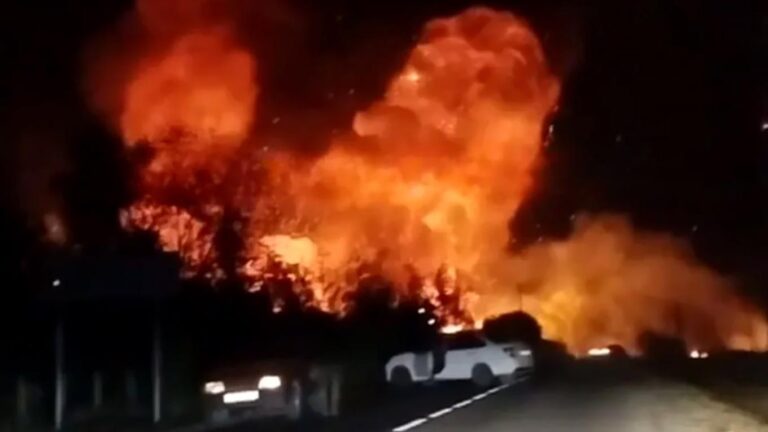In an unprecedented display of military capability, Ukraine launched a massive drone assault involving 251 unmanned aerial vehicles, striking multiple strategic targets across Russian-held territories. Explosions reverberated through Crimea, while critical power plants suffered severe damage, leading to widespread outages, including a blackout in Belgorod. This large-scale operation marks a significant escalation in the ongoing conflict, underscoring Kyiv’s intensified efforts to challenge Russian infrastructure deep within occupied zones.
Ukraine’s Tactical Drone Assault Targets Strategic Sites in Crimea
In a meticulously coordinated operation, Ukrainian forces unleashed a formidable drone assault comprising 251 tactical UAVs aimed at crippling key Russian infrastructure across Crimea and the Belgorod region. The relentless barrage resulted in multiple explosions that rocked vital energy sites, disrupting power supply and leaving significant swaths of Belgorod in blackout. Ukrainian military strategists emphasized the precision targeting of power plants, communication hubs, and logistical nodes, showcasing enhanced drone warfare capabilities that pivot Kyiv’s offensive into electrifying new dimensions.
Initial assessments from on-ground reports indicate that the strikes severely damaged at least three major power plants and created cascading failures across regional grids. The assault exposed vulnerabilities within the Russian defensive perimeter, revealing gaps in electronic warfare and early drone detection systems. Analysts warn that continued drone offensives on such a scale could escalate the conflict’s technological intensity, compelling Moscow to overhaul its strategic deployments in contested territories.
- Number of drones deployed: 251
- Primary targets: Power plants, communication centers, logistical facilities
- Immediate impact: Power outages in Belgorod region, disrupted utility operations in Crimea
- Strategic implication: Shift towards high-tech asymmetric warfare
| Location | Target Type | Damage Level | Operational Status |
|---|---|---|---|
| Crimea South Power Plant | Energy Facility | Severe | Offline |
| Belgorod Communication Hub | Telecom Center | Moderate | Partially Functional |
| Crimea North Logistics Base | Supply Depot | Minor | Operational |
Power Disruptions Ripple Through Russian Border Regions Amid Explosions
In a coordinated assault involving 251 drones, Kyiv launched a significant strike that triggered multiple explosions across key infrastructure in Crimea and Russian border regions. Among the hardest hit were power plants supplying electricity to Belgorod and its surrounding areas, resulting in widespread blackouts affecting thousands of households and critical facilities. The strikes not only disrupted energy supplies but also sent shockwaves through regional security frameworks, highlighting the escalating tension along the Russia-Ukraine frontier.
Emergency services in the affected regions scrambled to restore power as authorities declared heightened alert status. The scale of the disruption was underscored by the following immediate impacts:
- Blackouts lasted several hours in Belgorod, plunging the city into darkness during peak evening times.
- Communication networks experienced intermittent failures, complicating relief efforts.
- Critical infrastructure including water treatment plants faced operational challenges due to power loss.
| Region | Power Status | Estimated Recovery |
|---|---|---|
| Belgorod | Blackout | 6-8 hours |
| Crimea | Partial Outage | 4-6 hours |
| Russian Border Towns | Power Fluctuations | Ongoing |
Analyzing Ukraine’s Drone Strategy and Recommendations for Enhanced Defensive Measures
Ukraine’s recent deployment of a 251-drone barrage marks a significant evolution in its tactical approach to countering Russian military infrastructure. This unprecedented scale of unmanned aerial vehicle (UAV) usage reflects a calculated strategy aimed at overwhelming enemy air defenses through sheer volume and precision strikes. The attacks targeting key sites in Crimea, Russian power plants, and the blackout in Belgorod signal Kyiv’s shift toward a disruptive, technology-driven warfare mindset designed to cripple logistics and undermine Russia’s operational capabilities. By saturating defensive radar with multiple low-cost drones, Ukraine gains a tactical edge, complicating Russian attempts to intercept every threat while conserving valuable manned air assets.
To further enhance defensive measures against retaliatory strikes, Ukraine must invest in multi-layered counter-drone systems and bolster cybersecurity defenses. Potential improvements include:
- Deployment of electronic warfare units to jam and hijack drone control signals
- Integration of AI-powered radar and optical detection platforms for real-time threat identification
- Expansion of rapid-response mobile missile systems to neutralize incoming drone swarms
- Improved drone reconnaissance capabilities for anticipatory defense posture adjustments
| Defensive Measure | Purpose | Expected Impact |
|---|---|---|
| Electronic Warfare Units | Signal disruption and drone hijacking | Reduce enemy drone effectiveness by up to 60% |
| AI Detection Systems | Faster threat recognition | Cut response time by 40% |
| Mobile Missile Platforms | Intercept and destroy drones | Increase interception rate by 50% |
To Conclude
The unprecedented scale of Ukraine’s 251-drone assault signals a significant escalation in the ongoing conflict, highlighting Kyiv’s growing capabilities to target strategic sites deep within Russian-held territories. As explosions continue to disrupt critical infrastructure in Crimea and Belgorod, the situation remains fluid, with potential ramifications for regional security and power dynamics. Analysts will be closely monitoring Russia’s response in the coming days, as both sides brace for possible further intensification in the months ahead.




